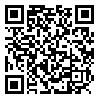BibTeX | RIS | EndNote | Medlars | ProCite | Reference Manager | RefWorks
Send citation to:
URL: http://ioh.iums.ac.ir/article-1-1978-en.html
Background and aims: Car Accident reports shows that the main cause of accidents is driver error and unsafe behavior. Workload of the major factors affecting driver that has a direct impact on the incidence of traffic accidents. This study aimed to evaluate aspects of mental work load of auditory-verbal secondary task was performed while driving.
Methods: Twenty professional bus driver randomly selected and participated in this study.
The bus driving simulator and the burden of driver activities (DALI) was used. Experiment was created from two blocks: the first block drivers are only driving activity carried out and the second block in addition to the driver, auditory-verbal secondary task also responded to. To compare the results of two blocks, independent t-test and to investigate the relationship between a brake reaction time and mental load analysis, Pearson correlation coefficient was used.
Results: The results showed that secondary task all aspects of mental workload increases significantly.
A brake reaction time and the number of collisions dramatically increased in terms of the secondary task. The relationship between mental workload and increase reaction time was seen braking and collision numbers.
Conclusion: The results of this study suggest that secondary task during driving can cause to increase the brake reaction time and risk of accidents by increasing the drivers’ mental workload of drivers and interfering with driving activity. These results indicate that driving experience does not reduce the effect of secondary activity during driving.
Received: 2016/12/10 | Accepted: 2017/10/16 | Published: 2018/04/7
| Rights and permissions | |
 |
This work is licensed under a Creative Commons Attribution-NonCommercial 4.0 International License. |





